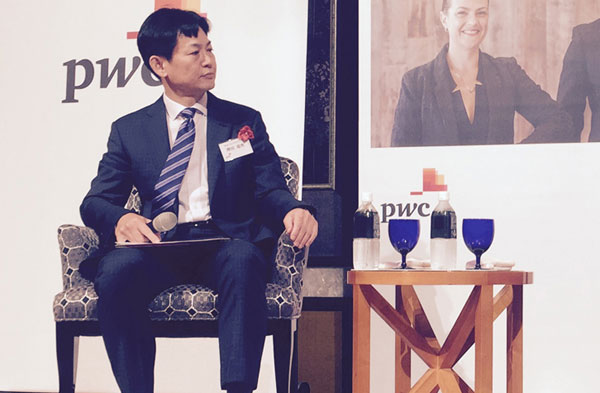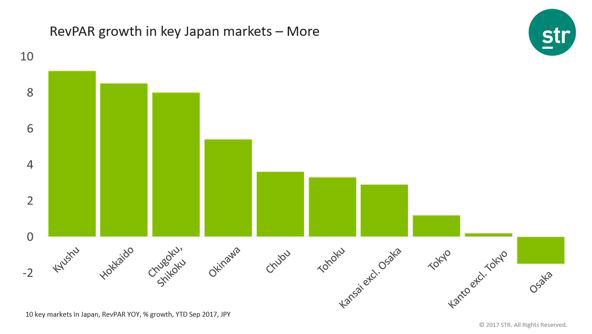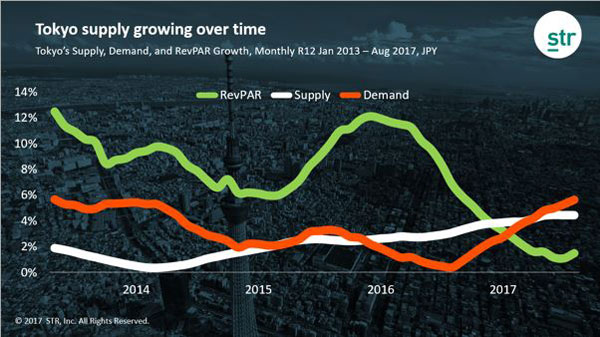✕

Column: industry Tag: hotel industry,growth of demand,Japan hotel performance Published: 2017-11-28 14:37 Source: Author:

Ryuji Sawada, of PwC Consulting, was host and organizer of the PwC Japan Hotel Management Forum at the Ritz-Carlton in Tokyo. (Photo: Jesper Palmqvist)
TOKYO—After a few years of formidable growth primarily from Asian markets like greater China, Japan’s international arrivals are projected to surpass 28 million in 2017. The Japan Tourism Agency forecasts that Japan—one of the top 10 most visited nations in the world—will see 40 million arrivals by 2020, the year Tokyo hosts the Summer Olympics.
Japanese authorities believe that existing infrastructure, along with current expansion plans in regional cities, is enough to handle the large influx of arrivals initially. But the potential and secondary expectation of 60 million arrivals years down the line would most likely mean that the country will need additional infrastructural help in airports and more, particularly around the Tokyo Narita area.
At the annual PwC Japan Hotel Management Forum on 1 November at the Ritz-Carlton in Tokyo, industry leaders discussed the opportunities and challenges ahead for Japan’s tourism and hospitality industry.
The host and organizer, Ryuji Sawada, partner of real estate and hospitality at PwC Consulting, commented on the upcoming potential challenges of “over-tourism”—for instance in Kyoto, one of the most popular destinations in Japan and a market whose economy is quite dependent on tourism.
Kyoto has started to face logistical challenges and tourist congestion with the influx of visitors, which will require local authorities to take measures such as aligning local transport pricing for better efficiency. The efforts to bring visitors to new markets and destinations around Japan must also continue, as tourism remains quite concentrated around Tokyo, Osaka and Kyoto today.
It is also important to study more mature and advanced tourism destinations around the world, Sawada said.
The fact remains that Japan is still catching up in terms of tourism management, and one of the major challenges ahead is human resources and a labor shortage, particularly in the growing hospitality industry, Sawada said. This is a challenge not only in terms of growing productivity and managing turnover, but the industry arguably needs to do a better job at attracting more people to work in hotels, and look at more foreign labor to resolve the issues as well as better automation and possibly robotics to reduce labor constraints.
Hotel performance in Japan
Hotel owners in Japan are taking advantage of the country’s growing demand. Shiori Sakurai, business development manager at STR, parent company of Hotel News Now, presented the latest hotel trends from around the world and Japan.
The overall performance for Japan’s hotels has continued to grow in 2017, with 2.6% year-to-date revenue per available room growth through September. We are now seeing the fastest growth in the north (Hokkaido) and south (Kyushu) regions of Japan with close to 10% RevPAR growth, whereas in central locations it has naturally slowed down to between 2% and 3% after years of very strong rate growth.
Sakurai also highlighted that Japan continues to have one of the highest overall occupancy levels in the Asia/Pacific, even ahead of Singapore.

While Osaka was the only main market to see decline in 2017 year-to-date RevPAR growth, it is important to remember that the city has seen very strong growth for up to five years before that. Also, some additional supply that is starting to come online is expected to soften the aggressive performance growth. This softening is currently affecting more midtier hotels than higher-end properties in Osaka, and this is a national trend in Japan overall, with the best rate growth happening either in luxury or midscale and economy hotel classes.
For quite some time, pipeline growth was very similar to the rate of inflation in Japan. The country’s pipeline has now grown in Japan and in Tokyo, and we are seeing close to 4% supply growth at the moment. So there is certainly movement, and new properties are coming online in the area.

STR continues to predict Tokyo will see positive RevPAR growth in 2018, but at a more balanced level in the low single digits.
More and more Japanese companies are looking abroad as well to introduce Japanese brands and diversify their portfolio exposure across Asia. After Japan-based Prince Hotels’ acquisition of Australia-based Staywell Hospitality Group, we are seeing more Japanese operators, including Mitsui Fudosan, Solare Hotels & Resorts and others actively looking to add hotels across Asia and beyond.
Alternative accommodations in Japan
Another fast-growing area is in what the Japanese refer to as “minpaku,” or private rental accommodations like HomeAway and Airbnb. Japan quickly grew to be one of the biggest private rental markets in Asia, as the revival of the business model coincided with the inbound travel growth and lack of new supply.
Although the model exists in Japan today, several laws have been passed, including rules limiting owners to lease out homes for more than 180 days in a year, and allowing local authorities to impose shorter time spans. Once the details of the framework of the upcoming legislation has been drafted, it will be implemented by the second quarter in 2018, opening up this vertical properly to both hosts and guests around the country.
Growth has been restricted by not only regulations, but also the fact that Chinese tourists are not using minpaku to the same extent as Europeans and North Americans. But the existing lack of higher-end hotels in key areas continues to drive growth of alternative accommodations, and one potential disruptor would be in secondary markets where there is still a gap in higher-end properties.
In Japan, cruises are one of the fastest-growing verticals, but local business is not seeing that high value in terms of local spend in tourism receipts.
Previous:Style and meaning are necessities for boutiques
Next:Sherwood Suites opens new residential property in Ho Chi Minh City
Hot key words
Hot Products
Popular Vendors